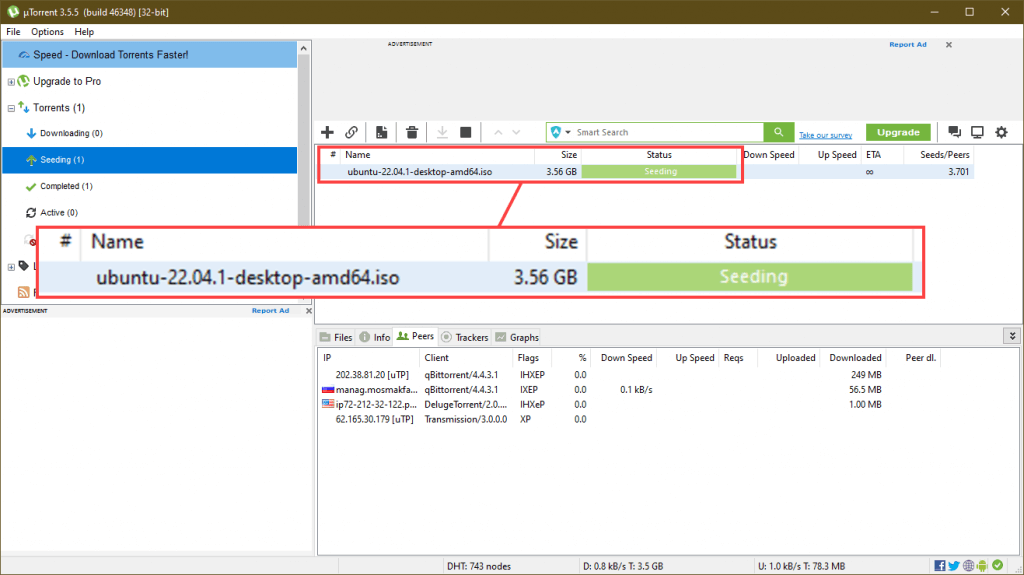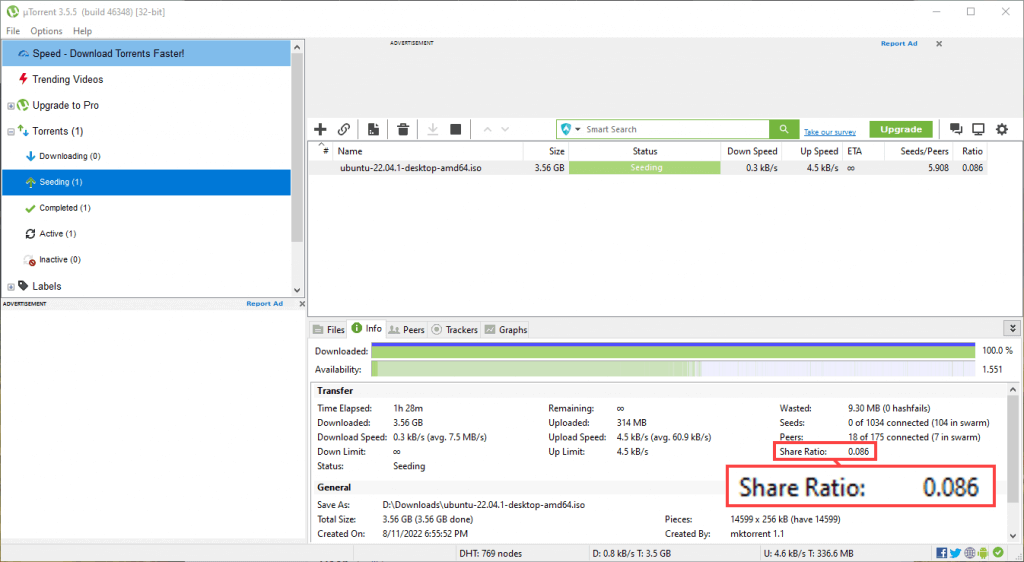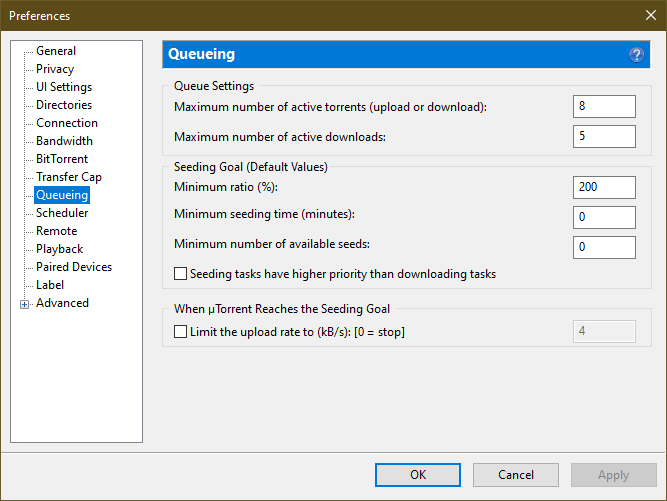To get the best out of torrenting programs like uTorrent, it’s important to understand what seeding is. Read on to learn everything you need to know about seeding in uTorrent.

Disclaimer: This material has been developed strictly for informational purposes. It does not constitute endorsement of any activities (including illegal activities), products or services. You are solely responsible for complying with the applicable laws, including intellectual property laws, when using our services or relying on any information herein. We do not accept any liability for damage arising from the use of our services or information contained herein in any manner whatsoever, except where explicitly required by law.
Table of Contents
- Understanding Peer-to-Peer Networking
- BitTorrent Clients
- Seeding in uTorrent
- The Role of Trackers in BitTorrent
- uTorrent Seeding Settings
- Conclusion
Understanding Peer-to-Peer Networking
First, let’s look at how files are transferred when you use a torrenting application. It’s quite different from most other file transfers online.
The Problem

Normally, when you download a file to your computer from the internet, you connect to a single remote computer, often called a server. This direct transfer is quite straightforward and works well for many daily tasks, but it has several drawbacks.
First, the speed of the transfer will be slow if the remote server has limited bandwidth. This problem is heavily compounded when the file(s) in question are in high demand. Hundreds or even thousands of people will try to download them all at once, all from one server. This often causes the server to become overloaded.
The server also needs to be available at a public IP address. This IP address can be used to trace where the server is located and what ISP it is on. Anti-piracy groups can quickly take down such file-sharing sites.
The Solution

Peer-to-peer (P2P) file-sharing protocols like BitTorrent work differently. It splits files into small parts. Everyone who downloads (“leeches”) a part of a file also shares (“seeds”) it with others who are attempting to download the file.
So, instead of downloading files from a central server that can quickly become overloaded, all the downloaders can get the parts of the files they need from other sharers, collectively known as “the swarm”.
The original seeder is no longer under extraordinary stress as the sole location the file can be downloaded from. Once several people have downloaded the file, the network stress on the original uploader can be quite low, as there are so many places people can download the file parts from.
In fact, the original seeder of a file can go offline after they’ve shared the file in its entirety. As long as all the file parts remain available somewhere in the swarm, peers can still download the complete file.
BitTorrent Clients
BitTorrent is the name of the protocol that coordinates the segmented file transfers between all the peers in the swarm. It was first authored and published by Bram Cohen in July 2001.
Several applications (most commonly known as “clients”) can be used to download and share files using the BitTorrent protocol. Our focus in this article is on uTorrent (also known as μTorrent), a popular proprietary BitTorrent client with a free, ad-supported download.
Other popular BitTorrent clients include Deluge, qBittorrent, and Transmission. While these all have different user interfaces, the basic ideas behind seeding and leeching also apply if you use a different client to uTorrent.
Seeding in uTorrent

Let’s look at how this all works in practice. Here is an example of a file being downloaded on uTorrent. On the left-hand side, you can see that there is one file downloading, and we are not seeding any files. This is because the file is still in transit to us and has not been completely transferred to our computer. We are still “leeching” the file at this point.
Seeds and Peers on a Torrent

At the bottom of the screen, in the Info panel, you can also see how many seeds and peers there are on this torrent.
At this moment in time, we are connected to 34 seeds—computers around the world that have a complete copy of the files in question. This is great, as we’ll be able to download all the various file parts from all these seeds, really helping our download speed.
We’re also connected to 3 peers—computers like us that don’t have a complete copy of the torrent files yet. These peers remain useful to us, as they’ll still be sharing some parts of the files we need. In the same way, we’re sharing the parts of the files we’ve downloaded with these peers, helping them to complete their file transfer faster.
Seeds and Peers in a Swarm
Also, notice the figures in brackets—the number of seeds in the swarm and the number of peers in the swarm. This gives us a general idea of the health of the torrent. In our example, though we’re not directly connected to them at the moment, there are 667 computers around the world currently sharing a complete copy of this file.
The more seeds a torrent has, the faster it can be downloaded. But perhaps even more importantly, when there are many seeds for a torrent, it will not disappear anytime soon. It’s only when the last seeder disappears that files will be unavailable forever.
Seeding Files in uTorrent

Once the file has been completely downloaded to our computer, the status of the file changes from Downloading to Seeding. This means we have a complete copy of the file, and people can continue to connect to us and download the parts of the file they need.
Maximize Your uTorrent Seeding with RapidSeedbox!
Experience faster, more efficient seeding with our powerful Seedbox.
Improve your share ratio by seeding files faster and longer.
Forget about bandwidth caps; enjoy unlimited seeding with uTorrent.
Keep your torrenting activities discreet and safe.
The Role of Trackers in BitTorrent
Before we discuss some more of the nuances of seeding in uTorrent, it’s important to understand how trackers fit into the BitTorrent infrastructure. Torrent files contain the details of one or more trackers that your BitTorrent client will connect to. Trackers, as their name suggests, keep track of which peers have which parts of files. They use this to instruct your client on which IP addresses they should connect to.
Having a pseudo-central resource at the heart of BitTorrent file sharing is a bit of a problem. Anti-file-sharing organizations can get the tracker shut down for legal reasons, causing all the shared files to become unavailable.
So, some innovations have been added to BitTorrent over the decades to allow file sharing to be tracker-less. Magnet links and DHT (distributed hash table), supported in uTorrent, allow torrent sharing to work without a central tracker.
Trackers and Seeding
Despite these innovations, trackers remain important in BitTorrent file sharing. Public trackers act as indexing services for torrents, making it easy to find magnet links to popular files.
But it’s for private trackers where our discussion of seeding is the most relevant. Private trackers usually expect more from their users than public trackers. They are often invite-only, and some charge a membership fee. In exchange, you usually get access to an extensive library of exclusive files, most of which are highly seeded.
Share Ratio
BitTorrent only works well when there are many seeders for files. Private trackers, therefore, often require you to keep seeding files long after they’ve finished downloading to your computer. Those who “hit and run”—disconnecting their BitTorrent client shortly after they’ve downloaded the entire file—are likely to be suspended or banned from the site.
Most private trackers that operate this way will automatically keep track of your share ratio. This is the ratio of how much you’ve uploaded compared to how much you’ve downloaded.

In uTorrent, you’ll find the share ratio of each of your files in the Info tab. In our example, despite having seeded the torrent for 88 minutes, we’ve only uploaded 8.6% of the amount of data we downloaded. We’ll probably need to keep seeding this file for several hours for there to have been enough people to download data from us to turn the share ratio to 1.0.
If your torrent is in demand and few people are seeding it, expect your share ratio to skyrocket as many people download from you. It will take longer for your ratio to improve on older or well-seeded torrents such as our example torrent.
So, you’ll often want to leave torrents seeding long after they’ve completed downloading. Beyond meeting private tracker ratio limits, it helps the health of torrent after you’ve downloaded its contents, allowing you to “pay it forward”.
Maintaining a healthy share ratio on private torrent tracker sites is one reason people often choose to rent a seedbox. Seedboxes will share your torrents on a fast, always-available network. This allows your share ratio to balloon because hundreds of people can concurrently download from you at a high speed.
uTorrent Seeding Settings
Because seeding is such a critical part of BitTorrent file sharing, there are several options for altering your seeding choices and optimizing uTorrent.
Global Seeding Settings
Hit Control-P in uTorrent and click on Queueing to find the settings most relevant to seeding. These settings affect how all your torrents work.

- Maximum number of active torrents / Maximum number of active downloads—Here, you can decide how many files can be active at a time. As there is a separate option for all torrents and just those that are downloading, you can use these settings to decide how many files will remain seeding. In our example, we can have 5 torrents downloading at the same time but up to 8 in total. So, even if we were downloading 5 torrents at a time, we could still be seeding a further 3 torrents.
- Minimum ratio (%)—If you set this ratio, uTorrent will continue to seed a torrent until you’ve uploaded enough to meet this ratio. It’s a percentage, so in our case, our torrents upload 2 times we’ve downloaded before throttling the speed of the torrent. You can set this to -1 if you want torrents to never be throttled.
- Minimum seeding time (minutes)—Set this if you want all your torrents to remain seeding for a certain number of minutes, regardless of ratio.
- The minimum number of available seeds—All torrents will keep seeding until at least this number of seeds is available on the torrent. This is a good option for ensuring older torrents remain available.
- Seeding tasks have higher priority than downloading tasks—Set if seeding is more important than downloading.
- When uTorrent reaches the seeding goal—Set this to the throttled speed in kB/s you want seeds to go at when they meet the seeding goal. Set it to 0 to automatically stop torrents when they meet the seeding goals you’ve set.
Individual Torrent Seeding Settings

Right-click on any of your seeding torrents in uTorrent and choose properties to set seeding goals for a specific torrent. You can click override default settings and set seeding goals that affect this torrent.
Another interesting setting here is Initial Seeding. Initial Seeding will distribute the file pieces as quickly as possible to the first connecting peers. If you have 10 peers connecting, each downloader will receive 10% of the file pieces, for example. Initial seeding can improve the initial uptake of a torrent. However, the benefits are marginal, and it can sometimes result in worse performance. If in doubt, leave it off.
Conclusion
In summary, when you are seeding a file in uTorrent, you are making it available for other peers in the swarm to download it from you. Seeding is the lifeblood of BitTorrent sharing—the entire system breaks down if no one is willing or able to seed a file. Seeding files also allows you to maintain a better share ratio on private tracker sites.
This is the best technical explanation made simplest possible for laymen that I have ever read online. Keep up Richard!